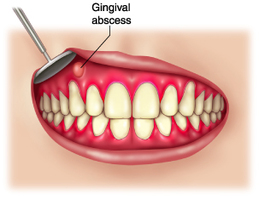
Dental or dentoalveolar abscess is a denomination used to describe localized collection of pus in the alveolar bone at the root apex of the tooth. It usually occurs secondary to dental caries, trauma, deep fillings or failed root canal treatment. Once the intact pulp chamber is breached, colonization of the root canals occurs with a diverse mix of bacteriological agents. The pathogenesis of dentoalveolar abscess is polymicrobial in nature, comprising of various facultative anaerobes, such as the viridans group streptococci and the Streptococcus anginosus group, and strict anaerobes, especially anaerobic cocci, Prevotella and Fusobacterium species. If the abscess ruptures, a sudden rush of foul-smelling and foul-tasting fluid will spill into the mouth.
In the mouth, abscesses form in the gums, teeth or roots of teeth. Bacteria can enter and cause an abscess in several ways:
- Through trauma (food or debris embedded deep in the gum)
- Through decay (a cavity) that leads into the tooth nerve and blood vessel (dental pulp)
- Through a deep gap (pocket) between the teeth and gums, in someone with gum (periodontal) disease
without burning your mouth,and rinse for two minutes every four hours, this will provide you
relief.
Avoid eating, hot, spicy and hard food.
Don't brush hard or chew hard foods from that area.
Healing compresses with wet tea bags could be also helpful with dental abscesses. Either black tea, green tea, or Echinacea tea would work. Simply soak it in warm water, place on the swollen area, then hold it. After pus is released, rinse with salt water, hydrogen peroxide solution, or other disinfectant.
Even if these remedies seem to help, but your abscess is continually draining, you need to see your dentist as soon as possible.
Good oral hygiene can help prevent abscesses. This means that you need to keep teeth and gums free of food.
